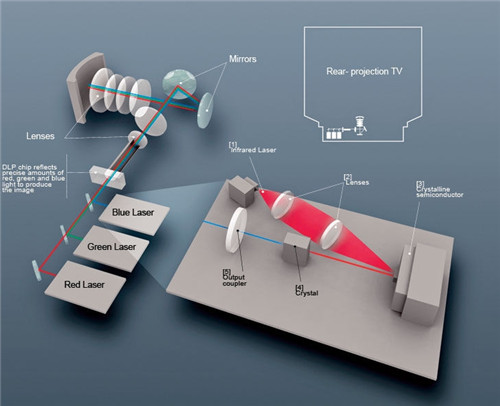
Fundamental
80% of humans' access to information in the external world comes from vision. Therefore, the display is an important way for modern people to obtain information. Display technology is an important development direction in the field of information.
Laser
A laser always emits light of a defined wavelength and color, which can be generated by the installation of a special crystal or light guide in front of the laser to produce red, green and blue colors, and then convert the laser into the desired color within these materials by so-called focusing. During the screening, the red, green and blue data are sent to the modem inside the laser unit. The video data is converted into optical information through amplitude modulation. The three-divided rays with red, green and blue lines are combined into a single laser beam, and the laser beam contains all the image information. The beam is then sent through the cable to the projection head and finally onto the screen.
how to work?
The principle of synthetic images of laser televisions is similar to that of televisions. The laser beam "sweeps" from top to bottom and from left to right. Horizontal deflection (row scanning) is achieved by a multi-faceted rotating mirror in the projection head, and vertical deflection (frame scanning) is achieved by a tilting mirror.
The laser light source of the laser television mainly has three kinds of realization methods, including three primary colors pure laser light source, fluorescent pink wheel plus blue laser, LED plus blue laser mixed light source.
3D effect
The laser light source itself is polarized light, which is the most suitable light source for expressing 3D effects. The combination of the two is also very easy, and there is no obstacle in fusion. It can be said that in the field of 3D display, laser television has unparalleled advantages, and 3D technology is also one of the main development directions of laser television.
For the TV signal source, since the three primary colors of the laser are different from the existing chromaticity points of the three primary colors of the fluorescent light, only the chrominance conversion of the video signal is required to be compatible with the existing program source.
background
From the initial CRT TVs to the flat-panel TVs represented by LCD, LED, and PDP, which occupy a major market share, and OLED third-generation display technologies actively deployed by Samsung, Changhong, TCL, Skyworth, Konka, etc. The development of display technology is at its peak. In 2010, LED LCD TVs with ultra-thin, energy-saving, large color gamut, long life, and other outstanding characteristics accounted for more than 30% of the sales of TVs in large and medium-sized cities, and are expected to reach 40% throughout the year. It is called "LED popularity for the first year."
During laser TV playback, the red, green and blue video data is sent to the modem inside the laser unit and converted into optical information through AM. The three types of rays with red, green and blue lines are combined into a single laser beam (including all image information. ), then through the optical cable to the projection head, and finally projected on the screen.
The horizontal deflection of the laser beam (line scan) is achieved by a multi-faceted rotating mirror in the projection head, and vertical deflection (frame scanning) is achieved by a tilting mirror. The working process is somewhat similar to that of a CRT TV, except that the electron beam of the CRT is scanned by deflection, and the photon beam of the laser TV is done by a prism.
People's demand for large-screen high-definition, with the laser display technology commercialization, laser television into the public view, Xiaomi also conducted a wave of popular education. The first commercial laser televisions entered the market in the late 1990s. In the past two decades, with the support of related technologies such as microelectronics and new materials, laser television has developed rapidly. The development of solid-state laser technology has made solid-state three-color light sources more efficient. Current laser television systems use all television standards such as PAL, NTSC, SECAM, VGA, or High Definition TV. Laser TV is the strongest contender in the 21st century TV market.
Laser TV Key Technology
The red, green and blue trichromatic laser light source determines the color space, life span, and working mode of the terminal display product based on the laser display technology.
Image modulation technology, which determines the display image resolution, contrast, brightness and other comprehensive performance indicators, the mainstream modulators are LCD, DLP and LCOS three.
Shimming and decoherence technology directly affect the efficiency of the laser display and the image signal-to-noise ratio.
Information processing techniques for large color gamut images include compression, storage, transmission, and demodulation of digital signals.
The key technology of the standard color display is the conversion from black and white to color. The key technology of the digital display is the high resolution and stable transmission of the picture. The key to the laser display technology lies in whether it can achieve full-color display.
Optical Rotary Sensor,Custom Encoder,Optical Encoder 6Mm Shaft,Handwheel Pulse Generator
Jilin Lander Intelligent Technology Co., Ltd , https://www.jllandertech.com